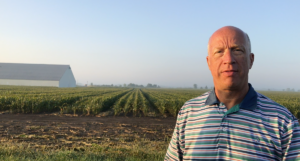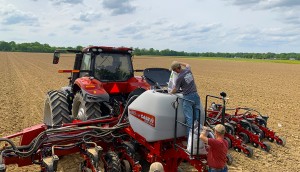Nitrogen Use Efficiency has quickly become part of the vocabulary surrounding sustainability. But NUE is more than just a buzzword or another fancy acronym. NUE is the benchmark for nitrogen management. You’ll often see it used to measure the amount of nitrogen used to produce a bushel of grain. NUE is a pillar for calculating CI scores, determining carbon offsets and growing sustainably produced crops. Reducing synthetic fertilizers, especially nitrogen, is a hallmark of regen ag programs. Growers are being rewarded by CPGs, retailers and biofuel makers for reducing the amount of nitrogen they apply to crops. But the trick is to cut nitrogen without cutting yields. Even today, many universities call for corn growers to apply 1.0-1.1 lbs. of nitrogen to produce one bushel of corn. In the Delta, many growers need to apply 1.6 lb. to N to produce a bushel of corn. On my test farm in west Tennessee, I grew 231 bu/A corn – even with green snap from 90-mph winds taking out about 25% of the stand just days prior to tasseling – while applying only 132 lbs./A of nitrogen. That’s a NUE of 0.57, which is about a third of what the norm is in this region. So how was that possible? All of my nitrogen was applied using Huma products, which contain Micro Carbon Technology (MCT). It is the most efficient device for delivering crop inputs, both to the roots and shoots. Thus, total volumes of nitrogen can be significantly reduced, effectively improving NUE. Want more evidence that NUE is going mainstream? A new nitrogen management contest category from National Corn Growers Association was tested this year, where contestants entered yield per unit of actual nitrogen applied. Entries were limited to the first 100 contestants from nine Cornbelt states. The national winning entry came from an Aurora, Nebraska grower, who grew 312 bu/A on 180 lbs. of nitrogen, for a nitrogen use efficiency score of none other than 0.57. Not that I’m keeping score or anything.
Maybe it was all that Holiday Cheer, but farmer sentiment (measured by the Purdue Ag Economy Barometer) remained largely unchained in December, albeit still on the low side and 10% lower than the start of the year. One area that did change was what keeps farmers up at night. Worry over low commodity prices spiked 30% over the previous month, surpassing interest rates and now trailing only higher input costs (31% to 26%) as their top concern. This will certainly be a trend worth watching. Worry over commodity prices does impact farmer buying decisions and can curb yield chasing.
When you are interviewed by the ag media, you never know when or how often the content will appear. That’s up to the editor or broadcaster. One year ago, I was interviewed by the Ag Information Network, a group of affiliated radio stations across the west. A story appeared on the Pacific Northwest Ag Network. Fast forward to January 2024, and this radio interview appeared last week on Idaho Ag Today, another affiliate. The content is still very relevant, and fits into the broadcaster’s narrative of “how farmers can balance their fam books” as they plan for 2024 crop production. Unfortunately, since it was conducted a year ago, our name was Bio Huma Netics.
Huma is proud to sponsor the 2024 Soilcraft Regen Ag Conference next week, January 17-19 in Coeur d’Alene, Idaho. Soilcraft is a great partner of Huma and are pioneers in regenerative agronomy. The conference features an outstanding line-up of speakers who will advise Soilcraft customers. Michael and I will be attending the event.
Related Posts

This Week in Ag #28
The recent fertilizer market may be best described by two catch phrases: “wait-and-see” and “just in time.” In the fall of 2021, sky-rocketing energy prices pointed toward looming inflation and an inevitable rise in fertilizer prices. Many savvy growers, including those aligned with the regen ag movement, hedged their bets by purchasing crop nutrients that

This Week in Ag #30
Labor Day signals the end of summer and ushers in the frolics of fall: football, pumpkin spice, UGG boots (well, maybe not in Arizona), hoodies, weenie roasts, and of course, harvest. When do farmers start harvest? For commodity crops, this is largely dependent upon the crop, the variety, geography, and the size of the farmer.

This Week in Ag #40
I’ll never forget the sage words an old farmer told me when I announced my intention to start farming in the late 1990s. I explained that I was not leaving my marketing job and that I was also doing a fair amount of freelance consulting work. He told me, “It’s funny how many other jobs you need

